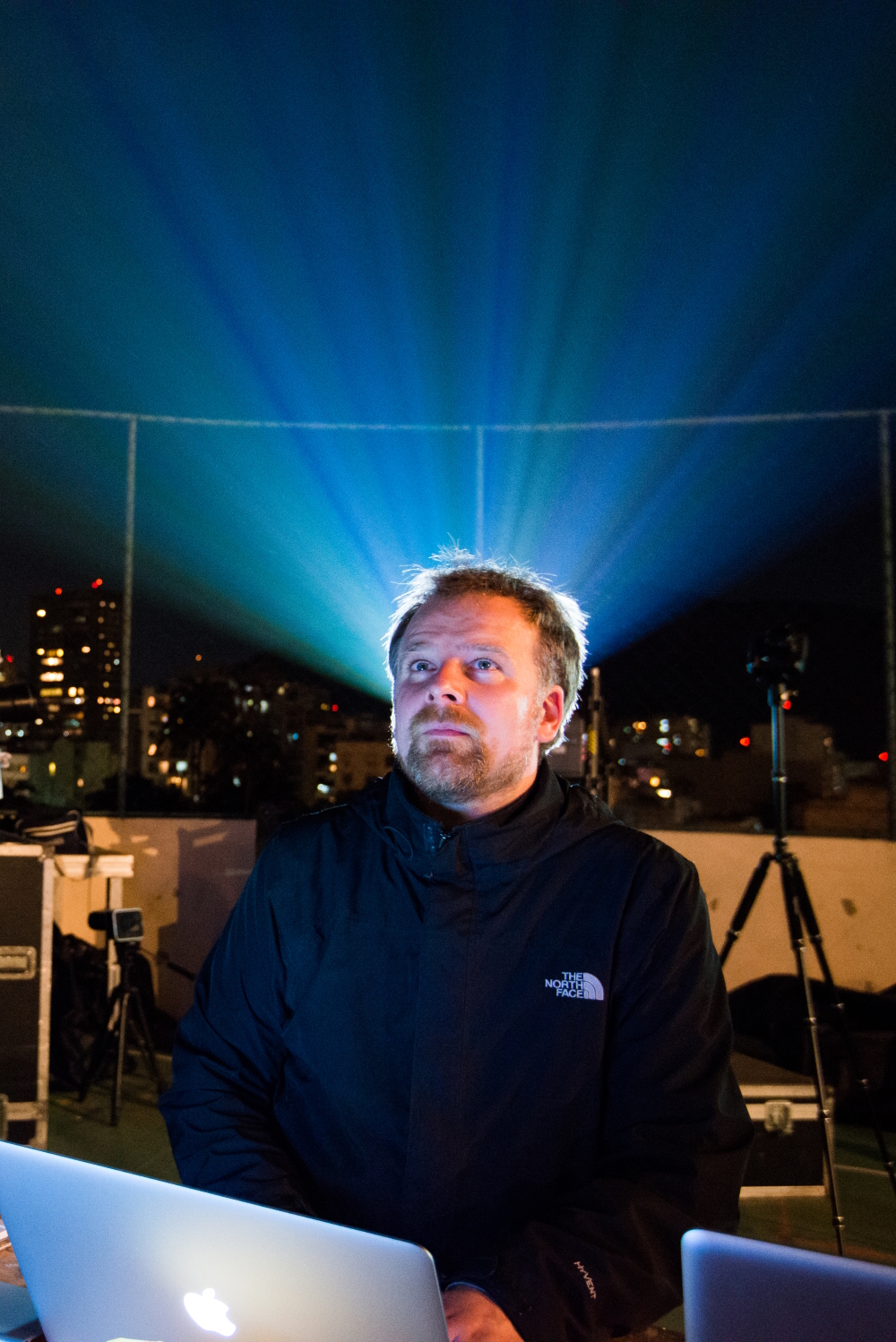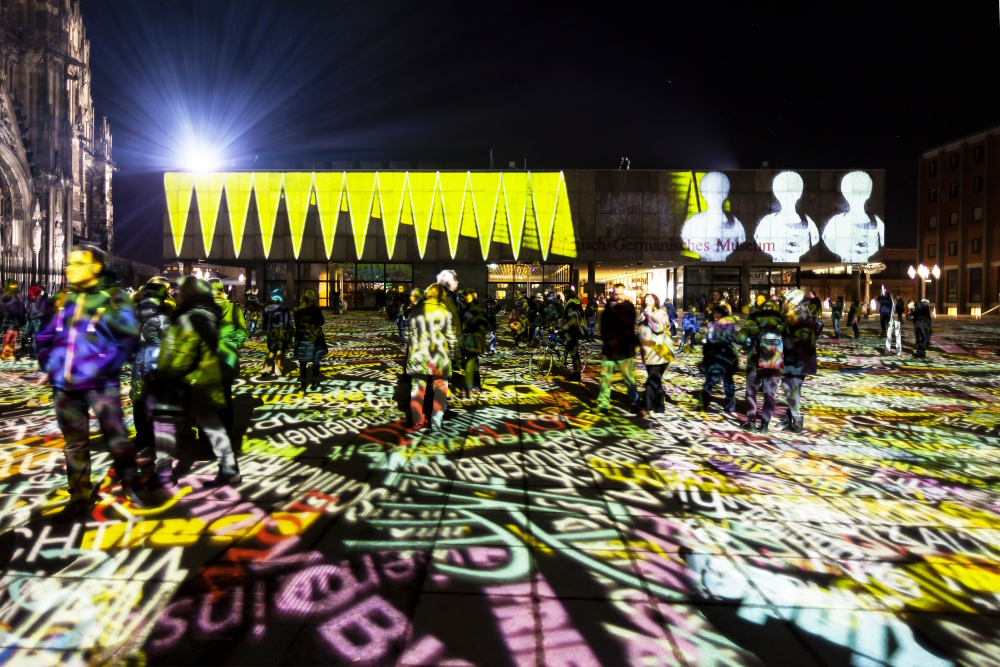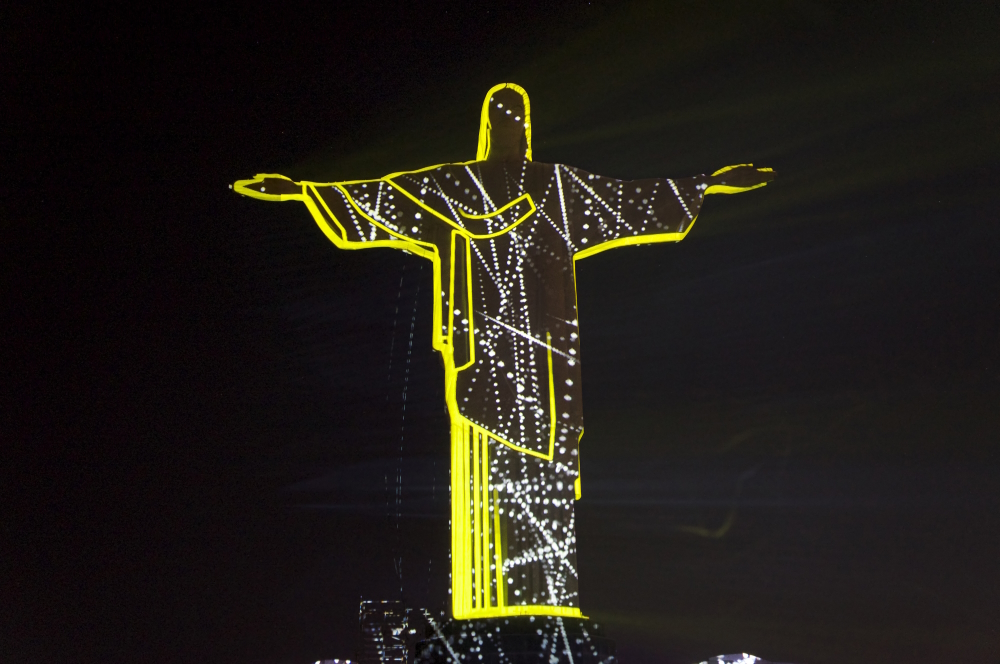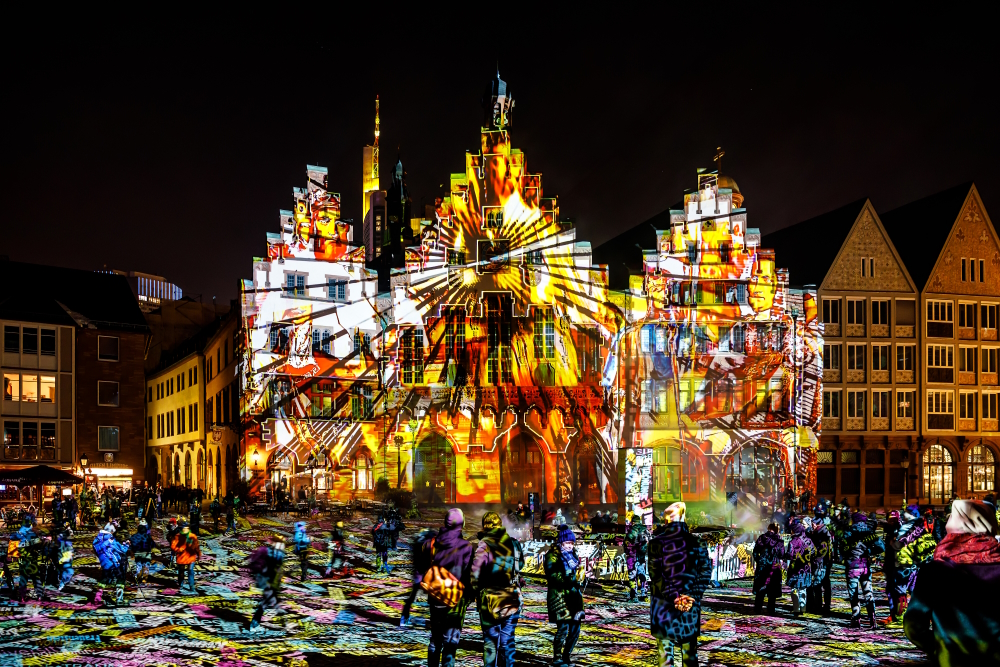Philipp Geist
Light / Visual Art / Projection Mapping
Germany
Pioneer of facade installations and video mapping. A few words are enough to describe the status and genre this creative is famous for. His light art and projections are shown worldwide since 1996. Be it Abu Dhabi, Bangkok, Barcelona, Berlin, Chicago, Dakar, Dubai, Jerusalem, Milano, Montreal, Moscow, Rio de Janeiro, Rome, Teheran, Vancouver, Venice or Zurich: everywhere viewers are overwhelmed by this kind of interactive art experience.
Philipp Geist
Light / Visual Art / Projection Mapping
Germany

Painting and photography were his first love. Philipp Geist (* 1976) then combined the two areas with audiovisual projects. These resulted in projections on buildings in immersive and light spaces. „There I discovered the possibility of also making these installations experienceable in such a way that they are not just a big projection on a wall or on a house“, the native German told thebicestercollection.com, „but that you can walk on them and the visitor also becomes part of the artwork really.“
Geist's projects are primarily characterized by their complexity in the integration of space, sound and moving images. His works have a painterly, compositional approach to overlays, structures and graphic elements including quotes from books and sometimes own photographs. The video mapping installations transform a wide variety of architectures in urban space into moving, painterly light sculptures that challenge the viewer's perception of two- and three-dimensionality.
„He deliberately projects his light art directly onto the façades“, notices bauhaus-dessau.de, „in order to invite the visitor to formulate his own sentences and individual stories about the artistic-philosophical theme of the figure in space from his evoked associations and, through a spatial depth and breadth of projection, to become part of the installation, to enter it, to sink into it. Geist develops a dialogue with the place, the architecture and his artistic work. Using contemporary technology, video projectors and computers, he creates painterly, abstract worlds of images in the moment, suggesting organic, microscopic structures. The works are constantly changing. Geometric, spatial forms such as squares, cubes, openwork surfaces, lines and rays overlap in a continuous process, building up an overall image only to dissolve it again in the next moment, giving rise to a complex pictorial architecture. Minimal-puristic, partly colour-intensive, dream-like and shadowy-fragile image compositions are created in this way. In his projections, ‚PG‘ often works with typographies and terms, from which abstract paintings on various façades are created through the multiple superimposition and repetition of the words.“ Bearing this in mind, it is no surprise what the enthusiastic table tennis player told Bavarian newspaper Münchner Merkur: "I always consider myself a painter!"
Philipp Geist lives and works in Berlin as well as Weilheim (Bavaria).
Interview February 2023
Painting with light: fasacades and space in (e)motion
INTUITION/IMAGINATION
How does intuition present itself to you – in form of a suspicious impression, a spontaneous visualisation or whatever - maybe in dreams?
I feel the intuition as a strong inner feeling to track down something and dive into it.
Intuition can be triggered for a variety of reasons: color perception, structures and visual rhythms. Intuition accesses stored and deeply rooted images and patterns.
Will any ideas be written down immediately and archived?
Sometimes I jot down ideas, draw them or try to implement them immediately. The best ideas deepen and you think about them first.
?: How do you come up with good or extraordinary ideas?
There is no formula here. no secret recipe. Ideas come and go, but it also requires the necessary time and calmness to develop ideas.
?: Do you feel that new creative ideas come as a whole or do you get like a little seed of inspiration that evolves into something else and has to be realized by endless trials and errors in form of constant developments up until the final result?
I do think that developing ides is a process that involves experimenting here, trying things out there and constantly developing. Coincidences and spontaneous attempts always give rise to new questions and answers.
What if there is a deadline, but no intuition? Does the first fuel the latter maybe?
For many projects I wait quite a long time until I have mentally penetrated so far into the ideas and the concept, have my elements together, developed my ideas and found a direction. Deadlines can help here from outside and the final phases of projects are often particularly fruitful with pressure.
INSPIRATION
What inspires you and how do you stimulate this special form of imaginativeness?
I am inspired by many different things: visual impressions, color patterns, colors, nature, shadow play, shapes, water reflections, patterns, color constellations, graphic elements. It is wonderful to work through the smallest elements in the thoughts, then also in the artistic work - to immerse oneself and to let variations arise from them again and again.
?: How do you filter between ideas worthwhile pursuing and bad ones that you just let go of?
Some ideas take months or even years to mature, are discarded again and again and then taken out again at some point. Other ideas are implemented immediately. There are also often spontaneous ideas, experiments that you try out and thus you always come up with new solutions and paths. This constant trying and researching is important. Sometimes the ideas work right away, sometimes they don't. Then you keep going until you reach that special point: the completion, the result, the work. this daily process, This daily challenge to oneself is incredibly motivating, fascinating and energizing. It is a fulfillment of dreams, wishes with one's own means and abilities.
Has it to appeal to you primarily or is its commercial potential an essential factor?
I am primarily interested in creating a work that interests me, that corresponds with my imagination. The commercial factor is irrelevant here. But it is also important to make something out of the works, to show them, to present them and, in the best case, to be successful with them. But first of all it is important to create a work authentically that meets one's own requirements.
Do you revisit old ideas or check what colleagues/competitors are up to at times?
Yes, own ideas are often taken up again. I also find it particularly exciting to bring different topics together. I combine my analogue painting with my digitally developed projections. Analogue meets digital. Very exciting combinations and new forms are created on this basis. I then project the generative content developed from the analogue image onto the painting. Of course you can also get inspiration from films, exhibitions, everyday life, etc. .
CREATIVITY
Which time/place/environment suits your creative work process the best (tranquillity or pressure) and which path do you take from theory/idea to creation?
I work daily on the various projects and artistic works. I start early in the morning and work all day until evening. Day by day. In the project phases, the time pressure is often very high. A lot is still possible under pressure, a highly creative phase. I often wait a long time with the projects and think about everything first, make drawings and collect ideas. Then when I'm ready, I "squeeze" everything out of me and bring everything together.
What is better in the realization process: speed and force creativity i.e. grasp the magic of the moment, or a slow, ripening process for implementation/elaboration?
The quick idea and implementation can be wonderfully strong and direct. With my live visual works this is the special attraction. To act intuitively and directly, to use all senses for expressing the visual ideas. I worked with many different musicians from different styles, with orchestras, with noise musicians, techno, jazz. In the best case, an audio-visual dialogue arises, a non-verbal exchange. But also in painting, thinking about the work for weeks and what is still missing even the picture is already finished. So both aspects are always necessary: stillness, stepping back and being spontaneous, immediate and direct.
?: Do you have any specific strategies you use when you are feeling stuck creatively?
Yes. Then I play table tennis, do sports, listen to music or go for a walk, ride the bike and try to distract myself, clear my head.
How important are self-doubt and criticism (by others) during such a process i.e. is it better to be creative on your own, only trust your own instincts, or in a team?
Self-doubt always plays a role of course, but you have to go through with it. My own standards are so high and the expectations of my work are often high. For me, of course, the first thing that counts is whether I'm satisfied with the work. everything else is not in your hands. Visitors interpret and think for themselves. But of course you are also happy when the great work, time and passion is recognized by the audience and a project is successfull. I always create my ideas by myself. In audio-visual works, the dialogue is exciting, to continue ideas in exchange in a ping-pong form.
Should a creative always remain true to him-/herself including taking risks & going against the flow or must one, for reasons of (commercial) survival, make concessions to the demands of the market, the wishes of clients and the audience’s expectations?
A work by an artist must remain authentic. That is the maxim. Commercial success usually only results from following your own authentic path. In commissioned work, I can only offer an authentic Philipp Geist. Everything else can be done by others. Often some topics are already specified by the request, the location and the occasion as well. What I make of it as an artist and how I react to it must remain a free, authentic project. Otherwise it is of no interest to me.
How is innovation still possible if one has established a distinctive style and, just in case, is it good to be ahead of one’s time even one hazards not being understood?
I think it's very important to always set new impulses for yourself and to develop your work further. But continuity and your own handwriting are also essential. I work digitally and analogue as well as in moving and still images, in painting with colors and pigments and on different computers purely digitally. I also try to combine both by projecting content digitally generated from the images onto my painted acrylic paintings. I call these works ‘Painting Mappings’. Or I generate digital film elements from analogue painting. Everything comes together. The constant exchange and experimentation, also contracting with different music can always bring new ideas and results: a wonderful cycle and creative process.
To a certain extent it is consistency, a unique visual language that has been developed for a long time. Why should you reinvent the rand every day? It should always be developed further. New content is added. New experiments may be possible.
When does the time come to end the creative process, to be content and set the final result free - or is it work-in-progress with an endless possibility of improvement?
In a work, an installation, an image, a projection, there is a certain point at which it is "finished". It is difficult to predict, but at some point everything is said. It can also happen that a picture stands around for weeks or slumbers on the computer and you look at it again and again and think about it or not at all and then pull it out again later. Everything needs its time. I wouldn't say that the work you've waited for months to do is better or worse. An unbelievable tension can also arise from some particular fast work. In case of installations, the elaboration often takes weeks and months when a certain topic is relevant. You have to do some research first of course. Since you are always working on your ‘handwriting’ and on coherent overriding themes, everything is connected in a way anyway.
?: In case of failure or - worse - a creativity crisis how do you get out of such a hole?
It's always up and down. The important thing is: just to keep going, keep on doing. Don’t worry, be happy! If a project didn't go well or there were mistakes, you're very depressed at first naturally, but then it goes on, new tasks and exciting moments await.
SUCCESS
Should/can one resist the temptation to recycle a ‘formula’ one’s successful with?
I also work on various projects in series, which are constantly being further developed in a site-specific manner. The basic idea is similar, but there are always new, distinctive projects. Projects that create a dialogue with place, visitors, space and the artistic work.in piece To a certain extent it is consistency, a unique visual language that has been developed for a long time. Why should you reinvent the rand every day? It should always be developed further, new content is added, new experiments may be possible.
Is it desirable to create the ultimate/timeless work, but doesn’t “top of the ladder” bring up the question of “what’s next?” i.e. isn’t such a personal peak “the end”?
I have an inner motor, a strong need to express myself visually. It fulfills me. Also to work intensely and hard. I have many projects and spend many, many hours developing these ideas. The end is open.
MY FAVORITE WORK:
An installation project series I've been working on since 2008 is the ’Time Drifts’-series. I was always able to implement this project locally at various locations around the world: Avignon (France), Jerusalem, Leeuwarden (The Netherlands), Montreal, Vancouver and cities in Germany like Berlin, Cologne, Darmstadt, Frankfurt, Oldenburg, Weilheim in Oberbayern, etc. . During the installation, I project onto the floor and the visitors, so they become part of the installation. There is no alignment of the installation but many perspectives are exciting. It is therefore a very spatial installation and not just a projection onto a large or small facade. I have always been developing this concept further, but at its core it remains the project series. I project terms onto the floor and the visitors walk across the square and immerse themselves in the terms.



